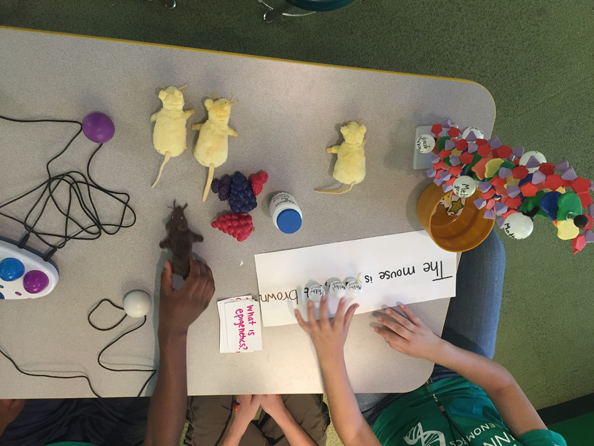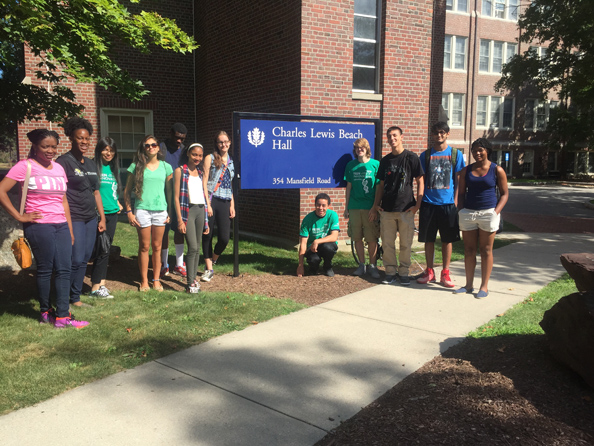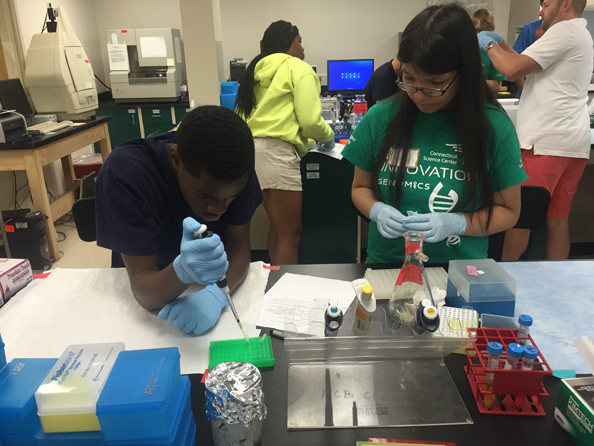Genome Ambassadors: Promoting Public Understanding of Genomics
This ISE-University Partnership Spotlight was co-authored by Rachel O'Neill, Professor and Head of Genetics and Genomics at the University of Connecticut, and Hank Gruner, Vice President or Programs at Connecticut Science Center.
Challenges in Genomic Literacy
Advances in genomics are rapidly increasing our understanding of not only the human body, disease, and health-related issues, but how humans and other species interact and respond to changing environments. Genomics represents a scientific frontier that connects with individuals and families at the most personal level, with the potential to shape the future of human healthcare. However, advances in genomics and their implications for personalized medicine are far outpacing public awareness and knowledge. The Connecticut Science Center (CSC) and the University of Connecticut have partnered under the NSF and Noyce Foundation-funded Science Education for New Civic Engagements-Informal Science Education (SENCER-ISE) initiative, at the National Center for Science & Civic Engagement, to address this issue. Rachel O’Neill, Professor and Head, Genetics and Genomics UCONN, Hank Gruner, Vice President of Programs at Connecticut Science Center, are designing activities for the public aimed at developing a conceptual understanding of genomics. The partnership serves several purposes including affording opportunities for postgraduate students to gain new perspectives on best practices in communication skills at the public-scientist interface and helping to frame the context for an upcoming CSC exhibit on genomics, “The Genome in Me”.

Goals for the Team
Over the course of three years, the project will develop a framework for an institutionalized, ongoing partnership between UCONN and the CSC to support the Genome Ambassadors Summer Fellowship program and the Teen Innovation Program in Genomics. The Genome Ambassadors program is designed to establish training for CSC program staff and students interfacing with the public in research and outreach activities in Public Genomic Literacy and engage postgraduate students in learning basic principles and best practices in communication with the general public. Targeting a different audience, but working with the Genome Ambassadors and CSC, the Summer Teen Innovation Program in Genomics is designed to allow teens interested in STEM careers to experience “life as a scientist” by helping to develop educational programs, technological applications, and exhibits to share with Science Center visitors.
As part of this mission, we are targeting three specific and measurable outcomes:
- CSC program staff will demonstrate an increased understanding of the fundamental principles of genomics in the context of applications to health, society, law, and ultimately personalized medicine.
- UCONN graduate students will demonstrate an ability to effectively communicate fundamental principles of genomics to a non-scientist (the CSC program staff).
- Instill a skill set/affect a positive attitude that allows participants to increase scientific communication skills and develop a sense of responsibility in public interaction. Outlining these goals, while seemingly straightforward, proved challenging. We figured out early in the process that in order to achieve our goals public literacy with regard to genomics was not the focus; rather it was the communication literacy of scientists working at the interface of public awareness (Science Center staff) and young scientists in training who are further removed from public settings but actively engaged in scientific discovery (UCONN PhD students in Genetics and Genomics fields of study). With this realization came the understanding that engendering best practices in communication skills would also inform our overarching goal of establishing a creative and active learning environment through a new genomics exhibit.

Front end evaluation
During the summer of 2014, graduate students from UCONN conducted interviews of 66 randomly selected adults visiting the Science Center to assess their awareness of genomics and understanding of core genomics concepts. Participants ranged in age from 18-76, with 94% having completed a college degree or taken at least some college level courses. This survey established a baseline assessment of public literacy in both classical genetics principles (e.g. how much of an offspring’s genetic code is inherited from each parent?) and modern genomics (e.g. what is genomics?; is only a small percentage of the genetic code utilized by each cell?). While a strong interest in genomics as it relates to personal and family health was evident from participant discussions, the assessments showed a lack of conceptual understanding in basic principles, confirming earlier studies on public awareness of genetics concepts performed by the American Association for the Advancement of Science. With this information, the Genome Ambassadors and UCONN/CSC partners were tasked with developing communication skills and activities to tackle the identified gaps in understanding and misconceptions in genomics literacy.

Iterative development
During the summer of 2015, graduate students in the Genome Ambassadors program worked with Science Center program staff and high school students in the Teen Innovation program to co-design and test genomics learning activities. The student’s led activities with families visiting the Science Center and with adults attending a farmer’s market in downtown Hartford, CT. The collective activities ended with a workshop for participants in the training facility of the Center for Genome Innovation within the UCONN Institute for Systems Genomics. During this workshop, students were asked to amplify a small piece of DNA from a “mystery sample”, get sequence information from this DNA, and query it against the National Center for Biotechnology and Information GenBank database of all curated and publicly available DNA sequences for a match. In doing so, partners identified the species of their DNA sample and were tasked with identifying why understanding their genome was of both general scientific interest and of importance for understanding human health and disease. Examples of “mystery DNA” included that of gibbons, the tammar wallaby, and the horseshoe crab.

The Final Phase – or really, Only the Beginning!
In the final year of the funded project (summer of 2016), students will continue to test and implement learning activities using additional embedded assessment. Data collected from formative evaluation of the activities is also being used to inform the design of a genomics exhibit planned for opening at the Science Center in 2017-2018. CSC and UCONN are committed to establishing a long-term, formal partnership with the goal of connecting the public with genomics learning experiences through informal STEM learning strategies and developing strong communication skills in public outreach as a core component of scientific training at the postgraduate level. For more on this project, visit the partnership’s page on the SENCER-ISE website. To read SENCER-ISE Perspective’s blog post from March 2015, click here For more on the increasing variety of informal STEM education and university partnerships, read CAISE’s blog series.